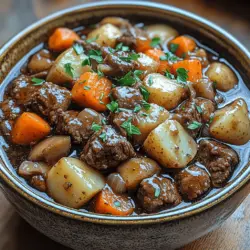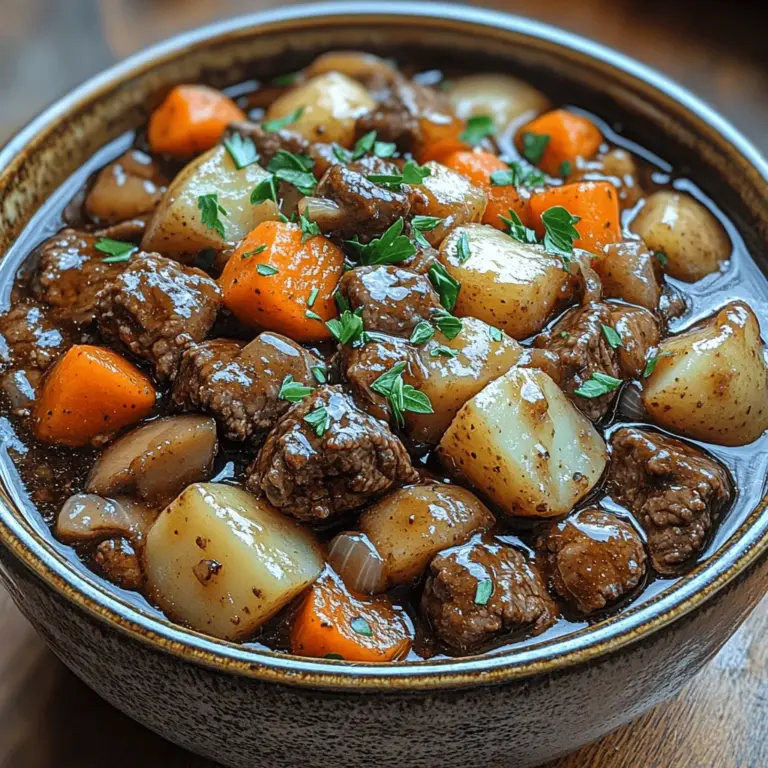Introduction
There’s something undeniably enchanting about the aroma of a slow-cooked meal wafting through your home. It evokes feelings of warmth, comfort, and nostalgia, transporting us to a place where hearty meals were enjoyed with family and friends. In our fast-paced world, the allure of slow-cooked dishes has never been more appealing. Enter the Slow Cooker Balsamic Beef Stew—a dish that embodies all the qualities we cherish in comfort food while fitting seamlessly into our busy lifestyles.
The beauty of using a slow cooker lies in its ability to transform simple ingredients into a rich, flavorful masterpiece with minimal effort. Imagine coming home after a long day to a meal that is not only ready to serve but also bursting with flavor. The Slow Cooker Balsamic Beef Stew is a perfect example of this convenience, requiring just a bit of preparation before you let the slow cooker work its magic.
At the heart of this stew lies the bold and tangy essence of balsamic vinegar, complemented by a medley of herbs and spices. The deep, rich flavors meld together over hours of gentle cooking, creating a dish that is both satisfying and soul-warming. Whether you’re looking to impress dinner guests or simply enjoy a cozy meal at home, this stew is sure to please.
Understanding the Ingredients
Before diving into the preparation steps, it’s essential to understand the ingredients that make this stew not only delicious but also nutritious. Each component has a specific role in creating the perfect balance of flavors and textures.
Beef Chuck
Starting with the star of the dish, beef chuck, this cut of meat is renowned for its rich flavor and tender texture when cooked low and slow. When choosing beef for stews, it’s crucial to select cuts that have enough marbling, as the fat renders down during cooking, adding moisture and enhancing the stew’s overall taste. Beef chuck, sourced from the shoulder area of the cow, is ideal for this recipe due to its hearty nature. It becomes incredibly tender and flavorful as it simmers in the slow cooker, making each bite melt in your mouth.
Olive Oil
Next up is olive oil, an essential ingredient for enhancing flavor and ensuring the perfect sear on the meat. Before slow cooking, the beef chuck is typically browned in olive oil, which not only adds richness but also contributes to the overall flavor profile. The oil aids in the Maillard reaction, a chemical reaction that occurs when proteins are exposed to high heat, resulting in that desirable golden-brown crust. Choosing a good-quality extra virgin olive oil can elevate the dish, imparting a subtle fruitiness that complements the other ingredients.
Aromatics
Aromatics such as onion and garlic are the foundational elements of flavor in many dishes, and this stew is no exception. Onions, when sautéed until translucent, develop a sweet, rich flavor that forms the base of the stew. Garlic, added towards the end of the sautéing process, provides a fragrant punch that enhances the dish’s complexity. Together, these aromatics create a deliciously savory foundation that permeates throughout the stew as it cooks.
Vegetables
The addition of vegetables like carrots, potatoes, and mushrooms not only boosts the nutritional profile but also adds textural contrast to the stew. Carrots lend a natural sweetness, while potatoes provide heartiness and substance. Mushrooms contribute an earthy depth that complements the beef beautifully. These vegetables soak up the flavors of the balsamic vinegar and herbs, making them a delightful addition to each spoonful.
Balsamic Vinegar
Balsamic vinegar is the key ingredient that distinguishes this stew from more traditional recipes. Its rich, tangy flavor brings a depth of acidity and sweetness, enhancing the overall richness of the dish. Balsamic vinegar is known for its ability to balance flavors, and in this stew, it acts as a brightening agent that cuts through the richness of the beef. The slow cooking process allows the vinegar to mellow, creating a harmonious blend of flavors that is sure to impress.
Herbs and Seasoning
Lastly, the importance of herbs and seasoning cannot be overstated. Fresh thyme and rosemary contribute aromatic notes that enhance the stew’s flavor profile, while bay leaves add subtle depth. A sprinkle of salt and freshly cracked black pepper at various stages of the cooking process ensures that the dish is perfectly seasoned, enhancing the natural flavors of the beef and vegetables.
Preparation Steps for the Perfect Stew
Now that we’ve explored the essential ingredients, it’s time to delve into the preparation steps that will lead you to a perfect Slow Cooker Balsamic Beef Stew. Each step is crucial in building layers of flavor and ensuring a delicious outcome.
Searing the Beef
The first step in preparing your stew is searing the beef. This crucial process involves heating olive oil in a large skillet over medium-high heat, adding the beef chuck pieces, and allowing them to brown on all sides. The Maillard reaction plays a pivotal role here; it’s what gives seared meat its deep brown color and robust flavor. Aim for a nice crust without overcrowding the pan, which can cause steaming rather than browning. Once the beef is beautifully browned, transfer it to your slow cooker.
Sautéing Aromatics
Next, it’s time to sauté the aromatics. In the same skillet used for the beef, add a bit more olive oil if necessary and toss in the chopped onions. Sauté until they are translucent and fragrant, which usually takes about 5 minutes. Add minced garlic towards the end of this process, cooking just until it becomes fragrant—be careful not to burn it, as burnt garlic can impart a bitter flavor. Once the onions and garlic are perfectly sautéed, add them to the slow cooker with the beef.
Adding Vegetables
After the aromatics, it’s time to add the vegetables. Layer the chopped carrots, diced potatoes, and sliced mushrooms over the beef and aromatics in the slow cooker. The order in which you layer the ingredients is important; placing the sturdier vegetables on the bottom allows them to cook evenly without becoming mushy. This layering technique also helps ensure that the beef remains on top, allowing the flavors to meld together beautifully.
Mixing Liquid Ingredients
Finally, it’s essential to mix the liquid ingredients that will form the stew’s base. In a separate bowl, combine balsamic vinegar, beef broth, and any additional seasonings you wish to include, such as salt and pepper. Pour this mixture over the layered ingredients in the slow cooker, ensuring that all components are well-coated in liquid. This step is crucial for balancing flavors; the balsamic vinegar should not overpower but rather enhance the overall taste of the stew.
With these preparation steps complete, you are now ready to set your slow cooker and let it work its magic. The combination of tender beef, rich balsamic flavor, and hearty vegetables will create a dish that not only fills the stomach but also warms the soul. As you continue with the cooking process, the aroma will fill your home, inviting everyone to gather around the table for a comforting meal. Stay tuned for the next part of this article, where we will explore cooking times, serving suggestions, and tips for the perfect Slow Cooker Balsamic Beef Stew.


